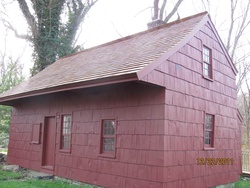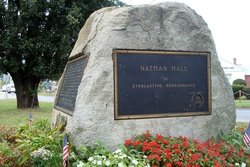American Revolution
By the last quarter of the eighteenth century, resentment of English authority was as strong here as in New England. In June 1774, alarmed by events in Boston and hoping to re-assert their rights as British citizens, Huntington adopted a “Declaration of Rights” affirming “that every freeman’s property is absolutely his own” and that taxation without representation is a violation of the rights of British subjects. The Declaration of Rights also called for the colonies to unite in a refusal to do business with Great Britain until the crisis in Boston was resolved.
The following year, 80 men assembled to drill and prepare for potential skirmishes with the English authorities. The New York Provincial Congress provided 100 pounds of gunpowder for the troops. In 1776, the Provincial Congress sent another 1,000 pounds. The gunpowder and a limited number of armaments and military equipment were kept in the home of weaver Job Sammis at the south end of the Village Green. Sammis’ house still stands and is now commonly known as the Arsenal in reference to its brief use as a military storage facility. 
The year of independence proved eventful—and tragic—for Huntington. The year started with the shipment of gunpowder. On July 22, news of the signing of the Declaration of Independence reached Huntington where it was met with great excitement. An effigy of the king was created using materials ripped from the red flag that included the British union and the words “GEORGE III” on one side and “LIBERTY” on the other. The union and the king’s name were removed, leaving a red flag with “LIBERTY” in white letters. The effigy was hung and blown up. Thirteenth patriotic toasts were made to celebrate the occasion.
The following month, the Liberty Flag, as it came to be known, was carried to the Battle of Long Island. Unfortunately, the American forces suffered a humiliating defeat. George Washington and his army had to escape to Manhattan at night under cover of fog. The British army meanwhile took control of Long Island arriving in Huntington on September 1 and remaining for the duration of the war.
A couple of weeks later, Nathan Hale volunteered to gather intelligence on the British forces in New York. He began his mission on the shores of Huntington Bay. He was later captured—it is unclear where, perhaps in Huntington or perhaps closer to the city—and hanged in New York City.
The occupying army forced Huntington residents to take oaths of allegiance to the Crown. If a man refused to take the oath, he and his family could be turned off their property, losing everything. The British established a headquarters in Huntington and used Long Island as a supply depot for the occupying forces in Manhattan. Crops and livestock were taken, horses and oxen were commandeered, and residents were forced to provide food, housing and labor.
The church, which had been built in 1715, was used as a stable and near the end of the war was dismantled to construct a fort on top of the town burying ground. Residents resisted as best they could. Men who had fled to Connecticut conducted raids across the Sound, aided by patriots who remained on Long Island. British troops were harassed. In 1781, American and French forces attacked Fort Franklin on Lloyd’s Neck, but were repulsed.
After independence had been secured and the British army evacuated, the church was rebuilt. The community itself was also rebuilt. By 1790, when George Washington stopped in Huntington for lunch during his tour of Long Island, Huntington had a population of 2,000. Twenty years later, the population had doubled to 4,424.